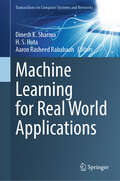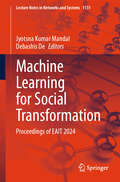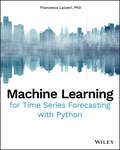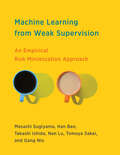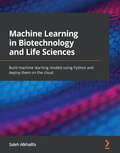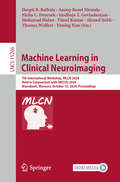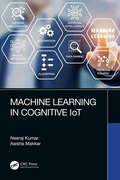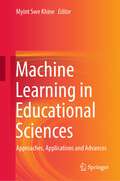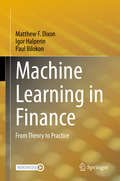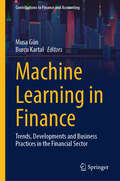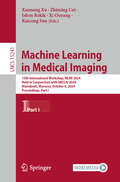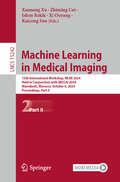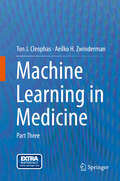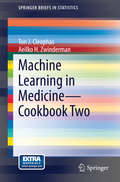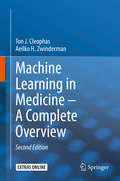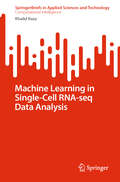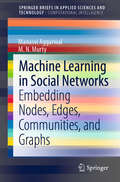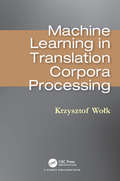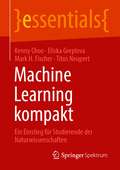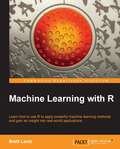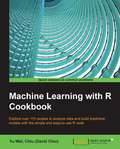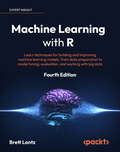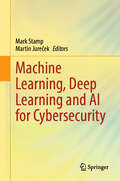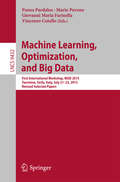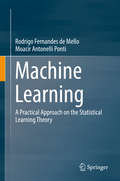- Table View
- List View
Machine Learning for Real World Applications (Transactions on Computer Systems and Networks)
by Dinesh K. Sharma H. S. Hota Aaron Rasheed RababaahThis book provides a comprehensive coverage of machine learning techniques ranging from fundamental to advanced. The content addresses topics within the scope of the book from the ground up, providing readers with a trustworthy source of theoretical and technical learning content. The book emphasizes not only the theoretical features but also their practical and implementation aspects in real-world applications. These applications are crucial because they provide comprehensive experimental work that supports the validity of the offered approaches as well as clear instructions on how to apply such models in comparable and distinct settings and contexts. Furthermore, the chapters shed light on the problems and possibilities that researchers might use to direct their future research efforts. The book is beneficial for undergraduate and postgraduate students, researchers, and industry personnel.
Machine Learning for Social Transformation: Proceedings of EAIT 2024 (Lecture Notes in Networks and Systems #1131)
by Debashis De Jyotsna Kumar MandalThe book includes original unpublished contributions presented at the Eighth International Conference on Emerging Applications of Information Technology (EAIT 2024), organized by Computer Society of India, Kolkata Chapter during 12 – 13 January 2024. The Theme of the conference is “Machine Learning for Social Transformation”. The book covers the topics such as computational intelligence for social transformation, machine learning for healthcare informatics, and machine learning for agriculture and environmental sustainability.
Machine Learning for Time Series Forecasting with Python
by Francesca LazzeriLearn how to apply the principles of machine learning to time series modeling with this indispensable resource Machine Learning for Time Series Forecasting with Python is an incisive and straightforward examination of one of the most crucial elements of decision-making in finance, marketing, education, and healthcare: time series modeling. Despite the centrality of time series forecasting, few business analysts are familiar with the power or utility of applying machine learning to time series modeling. Author Francesca Lazzeri, a distinguished machine learning scientist and economist, corrects that deficiency by providing readers with comprehensive and approachable explanation and treatment of the application of machine learning to time series forecasting. Written for readers who have little to no experience in time series forecasting or machine learning, the book comprehensively covers all the topics necessary to: Understand time series forecasting concepts, such as stationarity, horizon, trend, and seasonality Prepare time series data for modeling Evaluate time series forecasting models’ performance and accuracy Understand when to use neural networks instead of traditional time series models in time series forecasting Machine Learning for Time Series Forecasting with Python is full real-world examples, resources and concrete strategies to help readers explore and transform data and develop usable, practical time series forecasts. Perfect for entry-level data scientists, business analysts, developers, and researchers, this book is an invaluable and indispensable guide to the fundamental and advanced concepts of machine learning applied to time series modeling.
Machine Learning from Weak Supervision: An Empirical Risk Minimization Approach (Adaptive Computation and Machine Learning series)
by Nan Lu Masashi Sugiyama Han Bao Takashi Ishida Tomoya SakaiFundamental theory and practical algorithms of weakly supervised classification, emphasizing an approach based on empirical risk minimization.Standard machine learning techniques require large amounts of labeled data to work well. When we apply machine learning to problems in the physical world, however, it is extremely difficult to collect such quantities of labeled data. In this book Masashi Sugiyama, Han Bao, Takashi Ishida, Nan Lu, Tomoya Sakai and Gang Niu present theory and algorithms for weakly supervised learning, a paradigm of machine learning from weakly labeled data. Emphasizing an approach based on empirical risk minimization and drawing on state-of-the-art research in weakly supervised learning, the book provides both the fundamentals of the field and the advanced mathematical theories underlying them. It can be used as a reference for practitioners and researchers and in the classroom.The book first mathematically formulates classification problems, defines common notations, and reviews various algorithms for supervised binary and multiclass classification. It then explores problems of binary weakly supervised classification, including positive-unlabeled (PU) classification, positive-negative-unlabeled (PNU) classification, and unlabeled-unlabeled (UU) classification. It then turns to multiclass classification, discussing complementary-label (CL) classification and partial-label (PL) classification. Finally, the book addresses more advanced issues, including a family of correction methods to improve the generalization performance of weakly supervised learning and the problem of class-prior estimation.
Machine Learning in Biotechnology and Life Sciences: Build machine learning models using Python and deploy them on the cloud
by Saleh AlkhalifaExplore all the tools and templates needed for data scientists to drive success in their biotechnology careers with this comprehensive guideKey FeaturesLearn the applications of machine learning in biotechnology and life science sectorsDiscover exciting real-world applications of deep learning and natural language processingUnderstand the general process of deploying models to cloud platforms such as AWS and GCPBook DescriptionThe booming fields of biotechnology and life sciences have seen drastic changes over the last few years. With competition growing in every corner, companies around the globe are looking to data-driven methods such as machine learning to optimize processes and reduce costs. This book helps lab scientists, engineers, and managers to develop a data scientist's mindset by taking a hands-on approach to learning about the applications of machine learning to increase productivity and efficiency in no time.You'll start with a crash course in Python, SQL, and data science to develop and tune sophisticated models from scratch to automate processes and make predictions in the biotechnology and life sciences domain. As you advance, the book covers a number of advanced techniques in machine learning, deep learning, and natural language processing using real-world data.By the end of this machine learning book, you'll be able to build and deploy your own machine learning models to automate processes and make predictions using AWS and GCP.What you will learnGet started with Python programming and Structured Query Language (SQL)Develop a machine learning predictive model from scratch using PythonFine-tune deep learning models to optimize their performance for various tasksFind out how to deploy, evaluate, and monitor a model in the cloudUnderstand how to apply advanced techniques to real-world dataDiscover how to use key deep learning methods such as LSTMs and transformersWho this book is forThis book is for data scientists and scientific professionals looking to transcend to the biotechnology domain. Scientific professionals who are already established within the pharmaceutical and biotechnology sectors will find this book useful. A basic understanding of Python programming and beginner-level background in data science conjunction is needed to get the most out of this book.
Machine Learning in Clinical Neuroimaging: 7th International Workshop, MLCN 2024, Held in Conjunction with MICCAI 2024, Marrakesh, Morocco, October 10, 2024, Proceedings (Lecture Notes in Computer Science #15266)
by Vinod Kumar Yiming Xiao Mohamad Habes Thomas Wolfers Deepti R. Bathula Nicha C. Dvornek Sindhuja T. Govindarajan Anoop Benet Nirmala Ahmed NebliThis book constitutes the refereed proceedings of the 7th International Workshop on Machine Learning in Clinical Neuroimaging, MLCN 2024, held in Conjunction with MICCAI 2024 in Marrakesh, Morocco, on 10th October 2024. The 16 full papers presented in this volume were carefully reviewed and selected from 28 submissions. They are grouped into the following topics: machine learning; clinical applications.
Machine Learning in Cognitive IoT
by Neeraj Kumar Aaisha MakkarThis book covers the different technologies of Internet, and machine learning capabilities involved in Cognitive Internet of Things (CIoT). Machine learning is explored by covering all the technical issues and various models used for data analytics during decision making at different steps. It initiates with IoT basics, its history, architecture and applications followed by capabilities of CIoT in real world and description of machine learning (ML) in data mining. Further, it explains various ML techniques and paradigms with different phases of data pre-processing and feature engineering. Each chapter includes sample questions to help understand concepts of ML used in different applications. Explains integration of Machine Learning in IoT for building an efficient decision support system Covers IoT, CIoT, machine learning paradigms and models Includes implementation of machine learning models in R Help the analysts and developers to work efficiently with emerging technologies such as data analytics, data processing, Big Data, Robotics Includes programming codes in Python/Matlab/R alongwith practical examples, questions and multiple choice questions
Machine Learning in Educational Sciences: Approaches, Applications and Advances
by Myint Swe KhineThis comprehensive volume investigates the untapped potential of machine learning in educational settings. It examines the profound impact machine learning can have on reshaping educational research. Each chapter delves into specific applications and advancements, sheds light on theory-building, and multidisciplinary research, and identifies areas for further development. It encompasses various topics, such as machine-based learning in psychological assessment. It also highlights the power of machine learning in analyzing large-scale international assessment data and utilizing natural language processing for science education. With contributions from leading scholars in the field, this book provides a comprehensive, evidence-based framework for leveraging machine-learning approaches to enhance educational outcomes. The book offers valuable insights and recommendations that could help shape the future of educational sciences.
Machine Learning in Finance: From Theory to Practice
by Matthew F. Dixon Igor Halperin Paul BilokonThis book introduces machine learning methods in finance. It presents a unified treatment of machine learning and various statistical and computational disciplines in quantitative finance, such as financial econometrics and discrete time stochastic control, with an emphasis on how theory and hypothesis tests inform the choice of algorithm for financial data modeling and decision making. With the trend towards increasing computational resources and larger datasets, machine learning has grown into an important skillset for the finance industry. This book is written for advanced graduate students and academics in financial econometrics, mathematical finance and applied statistics, in addition to quants and data scientists in the field of quantitative finance. Machine Learning in Finance: From Theory to Practice is divided into three parts, each part covering theory and applications. The first presents supervised learning for cross-sectional data from both a Bayesian and frequentist perspective. The more advanced material places a firm emphasis on neural networks, including deep learning, as well as Gaussian processes, with examples in investment management and derivative modeling. The second part presents supervised learning for time series data, arguably the most common data type used in finance with examples in trading, stochastic volatility and fixed income modeling. Finally, the third part presents reinforcement learning and its applications in trading, investment and wealth management. Python code examples are provided to support the readers' understanding of the methodologies and applications. The book also includes more than 80 mathematical and programming exercises, with worked solutions available to instructors. As a bridge to research in this emergent field, the final chapter presents the frontiers of machine learning in finance from a researcher's perspective, highlighting how many well-known concepts in statistical physics are likely to emerge as important methodologies for machine learning in finance.
Machine Learning in Finance: Trends, Developments and Business Practices in the Financial Sector (Contributions to Finance and Accounting)
by Musa Gün Burcu KartalThis book discusses the evolution of technical features in decentralized finance and focuses on machine-learning finance in emerging economies. As technological advancement evolves at an unpredictable pace, the financial industry, like every other sector, must adapt accordingly. Furthermore, the rapid expansion of diverse financial products and services is creating new applications and markets. Alongside technological progress, the exploration of complex patterns in vast amounts of data, known as big data, is facilitated by its commonly acknowledged characteristics: volume, variety, veracity, value, and velocity. Overall, machine learning has become crucial in the financial industry, allowing businesses to automate operations, gain insights from data, and make more informed decisions in real time. This edited book covers algorithmic trading, risk management, fraud detection, customer service and personalization, portfolio management, credit scoring, sentiment analysis, and algorithmic pricing. The book connects theoretical concepts with practical real-world applications, benefiting professionals looking to enhance their proficiency in using these methods efficiently. It offers insightful guidance for theorists, market participants, and policymakers by exploring financial theories and practices in light of contemporary machine-learning approaches, with a special emphasis on emerging economies.
Machine Learning in Medical Imaging: 15th International Workshop, MLMI 2024, Held in Conjunction with MICCAI 2024, Marrakesh, Morocco, October 6, 2024, Proceedings, Part I (Lecture Notes in Computer Science #15241)
by Islem Rekik Xuanang Xu Zhiming Cui Xi Ouyang Kaicong SunThis book constitutes the proceedings of the 15th International Workshop on Machine Learning in Medical Imaging, MLMI 2023, held in conjunction with MICCAI 2024, Marrakesh, Morocco, on October 6, 2024. The 63 full papers presented in this volume were carefully reviewed and selected from 100 submissions. They focus on major trends and challenges in the above-mentioned area, aiming to identify new-cutting-edge techniques and their uses in medical imaging using artificial intelligence (AI) and machine learning (ML).
Machine Learning in Medical Imaging: 15th International Workshop, MLMI 2024, Held in Conjunction with MICCAI 2024, Marrakesh, Morocco, October 6, 2024, Proceedings, Part II (Lecture Notes in Computer Science #15242)
by Islem Rekik Xuanang Xu Zhiming Cui Xi Ouyang Kaicong SunThis book constitutes the proceedings of the 15th International Workshop on Machine Learning in Medical Imaging, MLMI 2024, held in conjunction with MICCAI 2024, Marrakesh, Morocco, on October 6, 2024. The 63 full papers presented in this volume were carefully reviewed and selected from 100 submissions. They focus on major trends and challenges in the above-mentioned area, aiming to identify new-cutting-edge techniques and their uses in medical imaging using artificial intelligence (AI) and machine learning (ML).
Machine Learning in Medicine
by Aeilko H. Zwinderman Ton J. CleophasMachine learning is a novel discipline concerned with the analysis of large and multiple variables data. It involves computationally intensive methods, like factor analysis, cluster analysis, and discriminant analysis. It is currently mainly the domain of computer scientists, and is already commonly used in social sciences, marketing research, operational research and applied sciences. It is virtually unused in clinical research. This is probably due to the traditional belief of clinicians in clinical trials where multiple variables are equally balanced by the randomization process and are not further taken into account. In contrast, modern computer data files often involve hundreds of variables like genes and other laboratory values, and computationally intensive methods are required. This book was written as a hand-hold presentation accessible to clinicians, and as a must-read publication for those new to the methods.
Machine Learning in Medicine - Cookbook Two
by Aeilko H. Zwinderman Ton J. CleophasThe amount of data medical databases doubles every 20 months, and physicians are at a loss to analyze them. Also, traditional data analysis has difficulty to identify outliers and patterns in big data and data with multiple exposure / outcome variables and analysis-rules for surveys and questionnaires, currently common methods of data collection, are, essentially, missing. Consequently, proper data-based health decisions will soon be impossible. Obviously, it is time that medical and health professionals mastered their reluctance to use machine learning methods and this was the main incentive for the authors to complete a series of three textbooks entitled "Machine Learning in Medicine Part One, Two and Three, Springer Heidelberg Germany, 2012-2013", describing in a nonmathematical way over sixty machine learning methodologies, as available in SPSS statistical software and other major software programs. Although well received, it came to our attention that physicians and students often lacked time to read the entire books, and requested a small book, without background information and theoretical discussions and highlighting technical details. For this reason we produced a 100 page cookbook, entitled "Machine Learning in Medicine - Cookbook One", with data examples available at extras. springer. com for self-assessment and with reference to the above textbooks for background information. Already at the completion of this cookbook we came to realize, that many essential methods were not covered. The current volume, entitled "Machine Learning in Medicine - Cookbook Two" is complementary to the first and also intended for providing a more balanced view of the field and thus, as a must-read not only for physicians and students, but also for any one involved in the process and progress of health and health care. Similarly to Machine Learning in Medicine - Cookbook One, the current work will describe stepwise analyses of over twenty machine learning methods, that are, likewise, based on the three major machine learning methodologies: Cluster methodologies (Chaps. 1-3) Linear methodologies (Chaps. 4-11) Rules methodologies (Chaps. 12-20) In extras. springer. com the data files of the examples are given, as well as XML (Extended Mark up Language), SPS (Syntax) and ZIP (compressed) files for outcome predictions in future patients. In addition to condensed versions of the methods, fully described in the above three textbooks, an introduction is given to SPSS Modeler (SPSS' data mining workbench) in the Chaps. 15, 18, 19, while improved statistical methods like various automated analyses and Monte Carlo simulation models are in the Chaps. 1, 5, 7 and 8. We should emphasize that all of the methods described have been successfully applied in practice by the authors, both of them professors in applied statistics and machine learning at the European Community College of Pharmaceutical Medicine in Lyon France. We recommend the current work not only as a training companion to investigators and students, because of plenty of step by step analyses given, but also as a brief introductory text to jaded clinicians new to the methods. For the latter purpose, background and theoretical information have been replaced with the appropriate references to the above textbooks, while single sections addressing "general purposes", "main scientific questions" and "conclusions" are given in place. Finally, we will demonstrate that modern machine learning performs sometimes better than traditional statistics does. Machine learning may have little options for adjusting confounding and interaction, but you can add propensity scores and interaction variables to almost any machine learning method.
Machine Learning in Medicine – A Complete Overview
by Aeilko H. Zwinderman Ton J. CleophasAdequate health and health care is no longer possible without proper data supervision from modern machine learning methodologies like cluster models, neural networks, and other data mining methodologies. The current book is the first publication of a complete overview of machine learning methodologies for the medical and health sector, and it was written as a training companion, and as a must-read, not only for physicians and students, but also for any one involved in the process and progress of health and health care.In this second edition the authors have removed the textual errors from the first edition. Also, the improved tables from the first edition, have been replaced with the original tables from the software programs as applied. This is, because, unlike the former, the latter were without error, and readers were better familiar with them.The main purpose of the first edition was, to provide stepwise analyses of the novel methods from data examples, but background information and clinical relevance information may have been somewhat lacking. Therefore, each chapter now contains a section entitled "Background Information".Machine learning may be more informative, and may provide better sensitivity of testing than traditional analytic methods may do. In the second edition a place has been given for the use of machine learning not only to the analysis of observational clinical data, but also to that of controlled clinical trials.Unlike the first edition, the second edition has drawings in full color providing a helpful extra dimension to the data analysis.Several machine learning methodologies not yet covered in the first edition, but increasingly important today, have been included in this updated edition, for example, negative binomial and Poisson regressions, sparse canonical analysis, Firth's bias adjusted logistic analysis, omics research, eigenvalues and eigenvectors.
Machine Learning in Single-Cell RNA-seq Data Analysis (SpringerBriefs in Applied Sciences and Technology)
by Khalid RazaThis book provides a concise guide tailored for researchers, bioinformaticians, and enthusiasts eager to unravel the mysteries hidden within single-cell RNA sequencing (scRNA-seq) data using cutting-edge machine learning techniques. The advent of scRNA-seq technology has revolutionized our understanding of cellular diversity and function, offering unprecedented insights into the intricate tapestry of gene expression at the single-cell level. However, the deluge of data generated by these experiments presents a formidable challenge, demanding advanced analytical tools, methodologies, and skills for meaningful interpretation. This book bridges the gap between traditional bioinformatics and the evolving landscape of machine learning. Authored by seasoned experts at the intersection of genomics and artificial intelligence, this book serves as a roadmap for leveraging machine learning algorithms to extract meaningful patterns and uncover hidden biological insights within scRNA-seq datasets.
Machine Learning in Social Networks: Embedding Nodes, Edges, Communities, and Graphs (SpringerBriefs in Applied Sciences and Technology)
by M.N. Murty Manasvi AggarwalThis book deals with network representation learning. It deals with embedding nodes, edges, subgraphs and graphs. There is a growing interest in understanding complex systems in different domains including health, education, agriculture and transportation. Such complex systems are analyzed by modeling, using networks that are aptly called complex networks. Networks are becoming ubiquitous as they can represent many real-world relational data, for instance, information networks, molecular structures, telecommunication networks and protein–protein interaction networks. Analysis of these networks provides advantages in many fields such as recommendation (recommending friends in a social network), biological field (deducing connections between proteins for treating new diseases) and community detection (grouping users of a social network according to their interests) by leveraging the latent information of networks. An active and important area of current interest is to come out with algorithms that learn features by embedding nodes or (sub)graphs into a vector space. These tasks come under the broad umbrella of representation learning. A representation learning model learns a mapping function that transforms the graphs' structure information to a low-/high-dimension vector space maintaining all the relevant properties.
Machine Learning in Translation Corpora Processing
by Krzysztof WolkThis book reviews ways to improve statistical machine speech translation between Polish and English. Research has been conducted mostly on dictionary-based, rule-based, and syntax-based, machine translation techniques. Most popular methodologies and tools are not well-suited for the Polish language and therefore require adaptation, and language resources are lacking in parallel and monolingual data. The main objective of this volume to develop an automatic and robust Polish-to-English translation system to meet specific translation requirements and to develop bilingual textual resources by mining comparable corpora.
Machine Learning kompakt: Ein Einstieg für Studierende der Naturwissenschaften (essentials)
by Kenny Choo Eliska Greplova Mark H. Fischer Titus NeupertDieses essential befasst sich mit Anwendungen des maschinellen Lernens in verschiedenen Bereichen der Naturwissenschaften. Es behandelt geläufige Strukturen und Algorithmen, um Daten mit den Techniken des maschinellen Lernens zu analysieren. Zunächst werden Methoden eingeführt, die an klassischen statistischen Analysen andocken und auf soliderem mathematischem Fundament stehen. Die Autoren machen mit den verschiedenen Strukturen für künstliche neuronale Netzwerke vertraut und zeigen die jeweiligen Anwendungsgebiete.
Machine Learning with R
by Brett LantzWritten as a tutorial to explore and understand the power of R for machine learning. This practical guide that covers all of the need to know topics in a very systematic way. For each machine learning approach, each step in the process is detailed, from preparing the data for analysis to evaluating the results. These steps will build the knowledge you need to apply them to your own data science tasks.Intended for those who want to learn how to use R's machine learning capabilities and gain insight from your data. Perhaps you already know a bit about machine learning, but have never used R; or perhaps you know a little R but are new to machine learning. In either case, this book will get you up and running quickly. It would be helpful to have a bit of familiarity with basic programming concepts, but no prior experience is required.
Machine Learning with R Cookbook
by Yu-Wei ChiuIf you want to learn how to use R for machine learning and gain insights from your data, then this book is ideal for you. Regardless of your level of experience, this book covers the basics of applying R to machine learning through to advanced techniques. While it is helpful if you are familiar with basic programming or machine learning concepts, you do not require prior experience to benefit from this book.
Machine Learning with R: Learn techniques for building and improving machine learning models, from data preparation to model tuning, evaluation, and working with big data, 4th Edition
by Brett LantzLearn how to solve real-world data problems using machine learning and RPurchase of the print or Kindle book includes a free eBook in PDF format.Key FeaturesThe 10th Anniversary Edition of the bestselling R machine learning book, updated with 50% new content for R 4.0.0 and beyondHarness the power of R to build flexible, effective, and transparent machine learning modelsLearn quickly with this clear, hands-on guide by machine learning expert Brett LantzBook DescriptionMachine learning, at its core, is concerned with transforming data into actionable knowledge. R offers a powerful set of machine learning methods to quickly and easily gain insight from your data. Machine Learning with R, Fourth Edition, provides a hands-on, accessible, and readable guide to applying machine learning to real-world problems. Whether you are an experienced R user or new to the language, Brett Lantz teaches you everything you need to know for data pre-processing, uncovering key insights, making new predictions, and visualizing your findings. This 10th Anniversary Edition features several new chapters that reflect the progress of machine learning in the last few years and help you build your data science skills and tackle more challenging problems, including making successful machine learning models and advanced data preparation, building better learners, and making use of big data.You'll also find this classic R data science book updated to R 4.0.0 with newer and better libraries, advice on ethical and bias issues in machine learning, and an introduction to deep learning. Whether you're looking to take your first steps with R for machine learning or making sure your skills and knowledge are up to date, this is an unmissable read that will help you find powerful new insights in your data.What you will learnLearn the end-to-end process of machine learning from raw data to implementationClassify important outcomes using nearest neighbor and Bayesian methodsPredict future events using decision trees, rules, and support vector machinesForecast numeric data and estimate financial values using regression methodsModel complex processes with artificial neural networksPrepare, transform, and clean data using the tidyverseEvaluate your models and improve their performanceConnect R to SQL databases and emerging big data technologies such as Spark, Hadoop, H2O, and TensorFlowWho this book is forThis book is designed to help data scientists, actuaries, data analysts, financial analysts, social scientists, business and machine learning students, and any other practitioners who want a clear, accessible guide to machine learning with R. No R experience is required, although prior exposure to statistics and programming is helpful.
Machine Learning, Deep Learning and AI for Cybersecurity
by Mark Stamp Martin JurečekThis book addresses a variety of problems that arise at the interface between AI techniques and challenging problems in cybersecurity. The book covers many of the issues that arise when applying AI and deep learning algorithms to inherently difficult problems in the security domain, such as malware detection and analysis, intrusion detection, spam detection, and various other subfields of cybersecurity. The book places particular attention on data driven approaches, where minimal expert domain knowledge is required. This book bridges some of the gaps that exist between deep learning/AI research and practical problems in cybersecurity. The proposed topics cover a wide range of deep learning and AI techniques, including novel frameworks and development tools enabling the audience to innovate with these cutting-edge research advancements in various security-related use cases. The book is timely since it is not common to find clearly elucidated research that applies the latest developments in AI to problems in cybersecurity.
Machine Learning, Optimization, and Big Data
by Panos Pardalos Vincenzo Cutello Mario Pavone Giovanni Maria FarinellaThis bookconstitutes revised selected papers from the First International Workshop onMachine Learning, Optimization, and Big Data, MOD 2015, held in Taormina, Sicily,Italy, in July 2015. The 32papers presented in this volume were carefully reviewed and selected from 73submissions. They deal with the algorithms, methods and theories relevant indata science, optimization and machine learning.
Machine Learning: A Practical Approach on the Statistical Learning Theory
by Rodrigo Fernandes de Mello Moacir Antonelli PontiThis book presents the Statistical Learning Theory in a detailed and easy to understand way, by using practical examples, algorithms and source codes. It can be used as a textbook in graduation or undergraduation courses, for self-learners, or as reference with respect to the main theoretical concepts of Machine Learning. Fundamental concepts of Linear Algebra and Optimization applied to Machine Learning are provided, as well as source codes in R, making the book as self-contained as possible.It starts with an introduction to Machine Learning concepts and algorithms such as the Perceptron, Multilayer Perceptron and the Distance-Weighted Nearest Neighbors with examples, in order to provide the necessary foundation so the reader is able to understand the Bias-Variance Dilemma, which is the central point of the Statistical Learning Theory.Afterwards, we introduce all assumptions and formalize the Statistical Learning Theory, allowing the practical study of different classification algorithms. Then, we proceed with concentration inequalities until arriving to the Generalization and the Large-Margin bounds, providing the main motivations for the Support Vector Machines. From that, we introduce all necessary optimization concepts related to the implementation of Support Vector Machines. To provide a next stage of development, the book finishes with a discussion on SVM kernels as a way and motivation to study data spaces and improve classification results.
